The story of clothing and costumes is one of the most fascinating developments in human history. Traditional Chinese Dress & Clothing has a long history and cultural content, and it is an important part of Chinese excellent cultural heritage, so It has particular researching value.
Every nation in the world has its unique traditional clothing. The particular histories and cultures could be recognized so as for people to distinguish one citizen from another.
China, as a multi-ethnic and time-honored country, has many ethnic minorities who have their indigenous culture. The mutual influences among these different cultures have contributed to the rich textures and fabrics of history and have made Chinese clothing with great variation and glory.
Traditional Chinese dress & clothing has been shaped and developed alongside the interactive influences between the outside world and China’s own dynastic traditions.
Every different dynastic has different scopes of territory, social values, social norms, etc. Therefore, many aesthetic standards were made according to the environments (socially, geographically, economically, politically) of certain dynastic. This is the main reason why traditional Chinese clothing has such many styles.
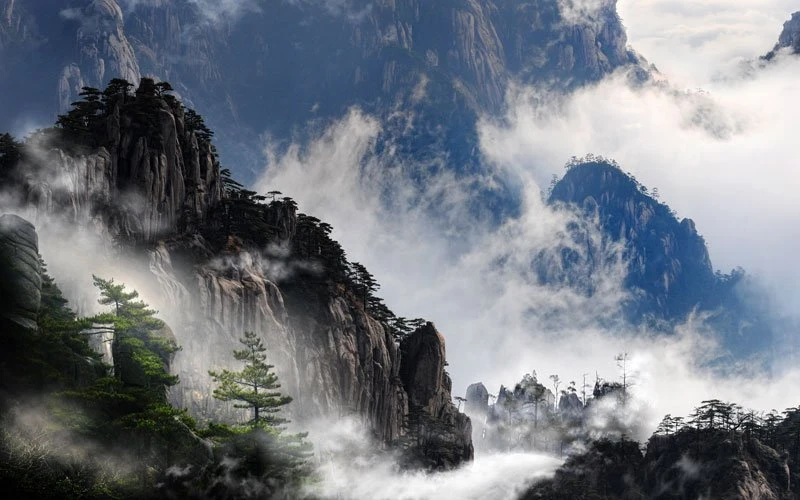
Mount Huang (黄山)
5 Types of Traditional Chinese Clothing & Dress
For exploring the world of traditional Chinese clothing, it is necessary to learn the most classic 5 categories: Respectively, Hanfu, Cheongsam, Tang suit, Zhongshan suit, and customs of the minority ethnics.
Every category has its own production techniques, and considerable discrepancies could be observed when comparing different categories or 1 category at different times.
This article provides a brief introduction to each category. By reading the following contents, the basic frameworks of traditional Chinese clothing could be structured.
1. Traditional Chinese Dress - Hanfu
Hanfu, with the name oriented from the Chinese meaning 'Han people's clothing,' encompassing all types and styles of traditional clothing worn by the Han Chinese.
The Han Chinese trace a common ancestry to the Huaxia, a name for the initial confederation of agricultural tribes living along the Yellow River. The term Huaxia represents the collective Neolithic confederation of agricultural tribes Hua and Xia who settled along the Central Plains around the middle and lower reaches of the Yellow River in northern China.

ao and horse-face dress (袄+马面裙)
Hanfu, as its definition, was born at the beginning of the history of Han ethnicity. Therefore, it has the longest history among all traditional Chinese clothing.
History of Hanfu
Hanfu has a history of more than three millennia. From the beginning of its history, Hanfu was inseparable from silk, supposedly discovered by the Yellow Emperor's consort, Leizu.
Hanfu dominated the Chinese fashion world from the Yellow Emperor's reign (2969 BC-2598 BC) to the end of the Ming Dynasty (1368 - 1644).
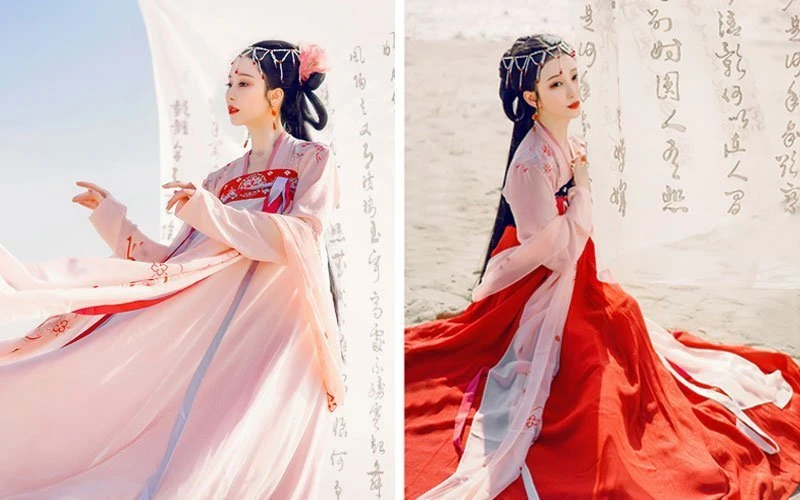
Qixiong Ruqun (齐胸襦裙)
Each dynasty has its own styles and aesthetics. For instance, Shenyi in Pre-Qin Dynasty; Ru dress in Qin and Han Dynasty; Tiaowenjiansequn in Wei Dynasty; Bambi in Sui and Tang Dynasty, etc.
Some dresses are popular and worn by people in different dynasties; some are just a flash in the pan. In both cases, all Hanfu has evolved and influenced by each other to some extent.
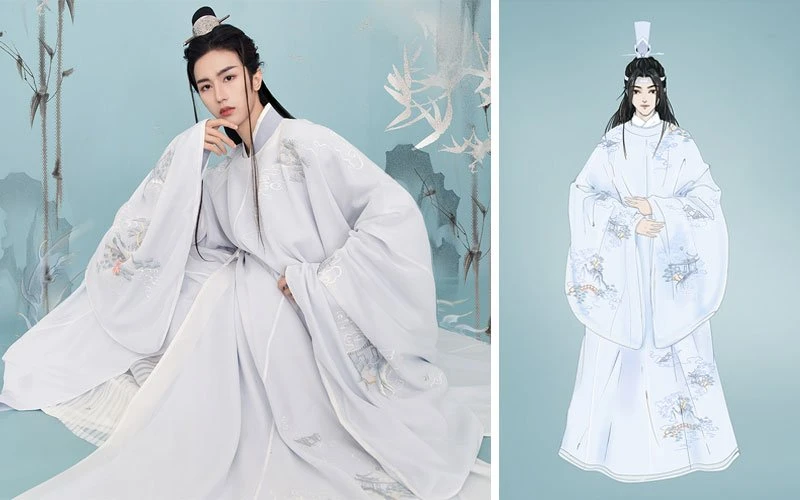
round collar robe (圆领袍)
Even though there are plenty of hanfu styles, each of them could be assembled by a set of clothing pieces.
| Yi (衣) | any open cross-collar garment, and worn by both sexes |
| Pao (袍) | any closed full-body garment, worn only by men in Hanfu |
| Ru (襦) | open cross-collar shirt |
| Shan (衫) | open cross-collar shirt or jacket that is worn |
| Qun (裙) or Chang (裳) | skirt for women and men |
| Ku (裈) | trousers or pants |
Apart from these, ancient Han Chinese were also accessorized with tassels, jade pendants, or various ornaments hung from the belt or sash, known as Pei (珮).
Follows are the introduction of some Hanfu styles.
| Zhongyi (中衣) or Zhongdan (中单) | inner garments, mostly white cotton or silk |
| Shanqun (衫裙) | a short coat with a long skirt |
| Ruqun (襦裙) | a top garment with a separate lower garment or skirt |
| Kuzhe (裤褶) | a short coat with trousers |
| Zhiduo/Zhishen (直裰/直身) | a Ming Dynasty style robe, similar to a shenyi but with vents at the side and 'stitched sleeves' |
| Daopao/Fusha (道袍/彿裟) | taoist/ buddhist priests' full-dress ceremonial robes |
| Xuanduan (玄端) | a very formal dark robe; equivalent to the Western white tie |
| Shenyi (深衣) |
a long full body garment |
| Quju (曲裾) | diagonal body wrapping |
| Zhiju (直裾) | straight lapels |
| Yuanlingshan (圆领衫), Lanshan (襕衫) or Panlingpao (盘领袍) | closed, round-collared robe; mostly used for official or academic dress |
2. Qing Dynasty Best - Cheongsam Qipao
Cheongsam, also known as Qipao in Mandarin, is a traditional dress that has its origins back in the 17th century. It is a type of famine body-hugging dress with distinctive Chinese features of Manchu origin. During the 1920s-1930s, it was called mandarin gown and popularized by upper-class women in Shanghai.
Qipao History
In the Qing dynasty, China was ruled by Manchus rather than Han Chinese. The rulers used an administrative division called the Eight Banner system. Originally, only the Manchu households were organized within this system, but Mongols and Han Chinese were incorporated over them.
The Manchus, and anyone living under the Eight Banners system, wore different clothing from ordinary civilians. Such clothing consisted of similar long robes for both men and women and was known as Changpao.
For a period of time, under the dynastic laws after 1636, all Han Chinese were forced under penalty of death to adopt the Manchu male hairstyle, the queue, and dress in Manchu Changpao instead of traditional Han Chinese Clothing.
However, in the 19th century, it was widespread for females to wear Qipao on formal and casual occasions voluntarily.
Nowadays, Cheongsam is recognized worldwide and has inspired many foreign adaptations because of its simple yet exotic lines. It is popular because it fits the Chinese female figure well, has simple lines, and looks elegant. It is suitable for wearing all year round for both young and elderly groups.
Modern females do not wear qipao as everyday attire. Cheongsams are now worn only during formal occasions like weddings, parties, and beauty pageants. Qipao is also used as a uniform at some Chinese restaurants, hotels, and airlines.
It is popularly worn in China as a wedding dress, traditionally in red. Cheongsam is usually embroidered with elaborate gold and silver designs. Brides in southern China wear Qipao or a modified two-piece style, elaborately adorned with a gold dragon and phoenix pattern. Dragon and Phoenix is a traditional wedding dress favored by Chinese brides nowadays.
3. Men's Style - Tang Suit
The Tang suit, also been translated as Tangzhuang, often refers to a type of modern Chinese jacket rather than the Tang Dynasty's clothing (AD 618 – 907).
Origin of name
Although the Tang suit is not clothing in the Tang dynasty, it has something to do with it. The Tang dynasty is one of the most prosperous times in Chinese history. As a result, people usually use the word Tang to refer to traditional Chinese culture. For example, Chinatowns in the U.S. or the U.K. are also be called Tang People Street.
Tang suits, as Tang People Street's name, represent certain clothing of deep traditional Chinese cultures.
Tang Suit History
The Tang suit history could be traced back to the early 1900s (at the end of the Qing Dynasty). It is the product of the combinations between Manchu’s jacket elements and the western jacket elements.
The Chinese government had released a new uniform system in 1929. With this new system, the Tang suit had become one of the national formal attire for males.
It was also around 1929, the media throughout the world reported and introduced the Tang suit widely. People around the world started regarding the Tang suit as one of the most typical traditional Chinese clothing.
In recent years, with various styles and production techniques, the Tang suit is getting more and more popular in China and globally.
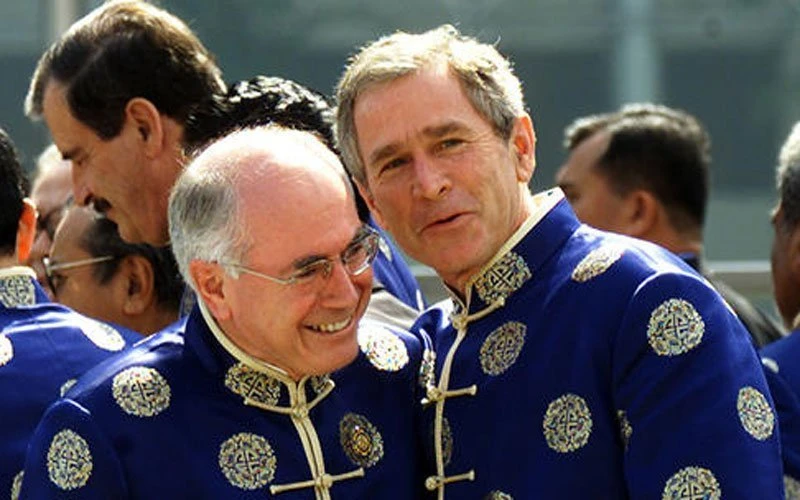
president's with Tang suit at 2001 APEC
Tang suit has appeared in many international events. On the Asia Pacific Economic Cooperation (APEC) in 2001, all national leaders wore a tang suit in royal blue, scarlet, and embroidered with a round pattern of peonies- China’s national flower. Furthermore, the Tang suit could also be seen at the 2008 Olympic Games and some of the World Trade Organization meetings.
In addition, Tang suit elements were being utilized many times infamous Kung Fu films and dramas. The efforts of both designers and cultural industries spread the influence of the Tang suit further and further.
4. Formal Attire - Zhongshan Suit
The modern Chinese tunic suit is a style of male attire originally known in China as the Zhongshan suit (after Sun Yet-Sen, also called Sun Zhongshan), and later as the Mao suit (after Mao Zedong).
Sun Yat-sen introduced the style shortly after the Republic of China's founding as a form of national dress although with distinctly political and later governmental implications. He based the suit on the Japanese Cadet uniform.
The suit was also known to have cultural implications. The four pockets represented the Four Virtues of the Chinese culture: Propriety, Justice, Honesty, and Shame, and the five buttons represented China's five branches of government.
History of the Zhongshan Suit
When the Republic was founded in 1912, the dress style in China was based on Manchu dress (qipao and changshan), which had been imposed by the Qing Dynasty as a form of social control.
The majority of Han Chinese revolutionaries who overthrew the Qing were fueled by the failure of the Qing to defend China and a lack of scientific advancement compared to the West. Even before the Republic's founding, older forms of Chinese dress were becoming unpopular among the elite and led to the development of Chinese dress, which combined the Changshan and the Western hat to form a new dress. The Zhongshan suit is a similar development that combined Western and Eastern fashions.
The Mao suit remained the standard formal dress for the first and second generations of PRC leaders such as Deng Xiaoping. During the 1990s, it began to be worn with decreasing frequency by leaders of General Secretary Jiang Zemin's generation as more and more Chinese politicians began wearing traditional Western-style suits with neckties.
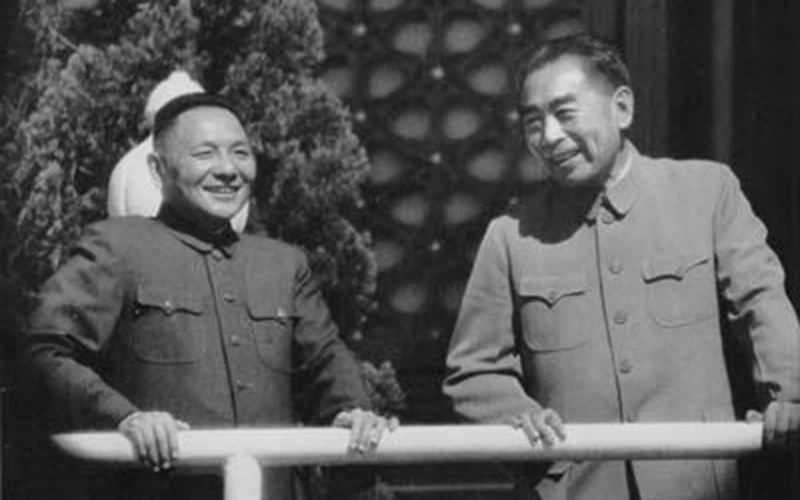
Deng Xiaoping and Zhou Enlai (邓小平和周恩来)
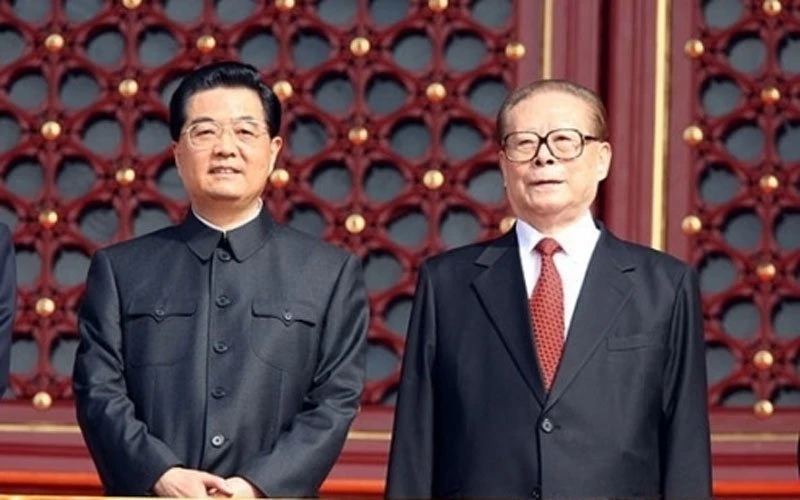
Hu Jintao and Jiang Zemin (胡锦涛和江泽民)
Jiang Zemin and Hu Jintao only wore the Mao suit on special occasions, such as important diners or the ceremony marking the 60th anniversary of the People's Republic in 2009.
Hu Jintao even showed up to a black-tie state dinner in the United States wearing a business suit, attracting criticism for being underdressed at a formal occasion. However, in the Xi Jinping administration, the Mao suit made a comeback as a diplomatic uniform and evening dress.
5. Ethnic Minorities - Colorful Costumes
Some countries, such as Japan, Korea, France, and Greece, are mono-ethnic countries. China is not one of them which has multi ethnics living in down the ages.
Ethnic minorities in China are the non-Han Chinese population in China. China officially recognizes 55 ethnic minority groups within China in addition to the Han majority. As of 2010, the combined population of officially recognized minority groups comprised 8.49% of mainland China's population.
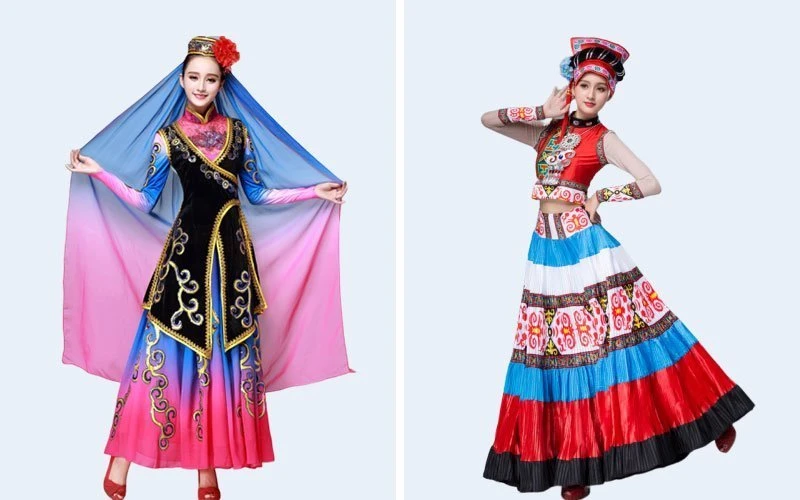
Hui ethnic and Yi ethnic (回族和彝族)
The degree of variation between ethnic groups is not consistent. Many ethnic groups are described as having unique characteristics from other minority groups and the dominant Han. Still, some are very similar to the Han majority group. Most Hui Chinese are indistinguishable from Han Chinese except that they practice Islam, and most Manchu are considered to be largely assimilated into dominant Han society.
The 55 ethnic minorities are Mongolian, Hui, Tibetan, Uygur, Miao, Yi, Zhuang, Dai, etc.
As to the clothing of the ethnic minorities, great variations could be observed due to the geographical, cultural, and historical factors.
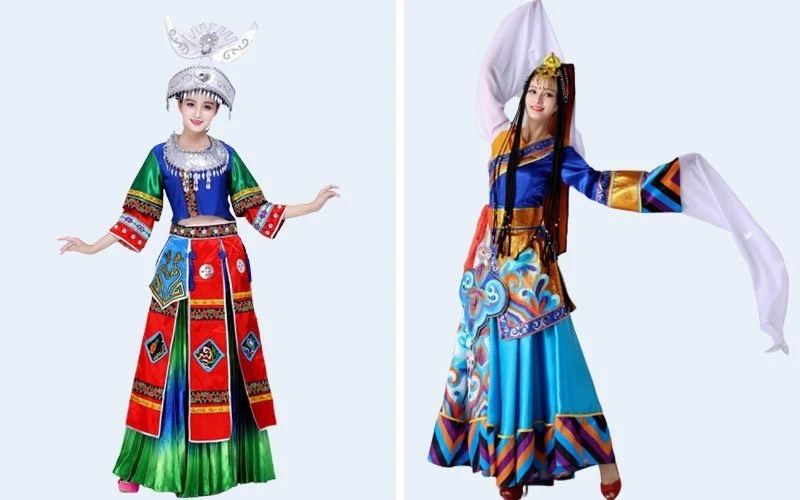
Miao ethnic and Zang ethnic (苗族和藏族)
Features of Clothing
Common features of ethnic minority clothing are flowery and colorful, extremely exquisite, and highly distinctive.
Every aspect of their garments, such as raw materials, textile technology, fashion, and decoration, retains a distinct characteristic of the ethnic group and the locality. The Hezhen ethnic minority people, who mainly make a living on fishing, used to make clothes with fishskin. The hunting ethnic groups, such as Oroqen and Ewenki, used roe skin and animal tendon to stitch up their clothes.
The Mongolians, Tibetans, Kazakstans, Khalkhases, Yugurs, etc., mainly engaged in stockbreeding, make their apparel mostly from animal skin and hair. And, farming ethnic minorities usually take the locally produced cotton or hemp thread as raw materials to spin cloth and silk and make clothes.
Ethnic minorities' spinning and weaving, tanning, and felting techniques boast a long history. For example, the Li ethnic minority's bombax cloth, the woolen fabric of the Tibetan, Adelis silk of the Uygur, and fur products of the Oroqen have enjoyed a worldwide reputation all along.
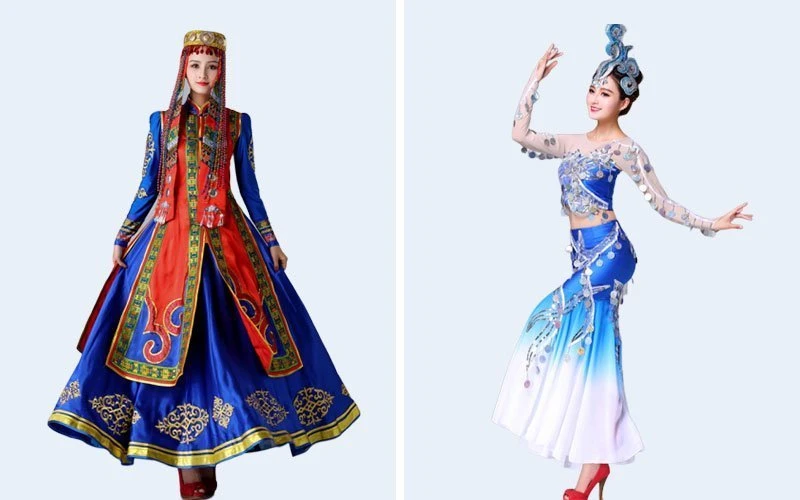
Mongolian ethnic and Dai ethnic (蒙古族和傣族)
There are numerous clothing designs and forms in Chinese ethnic minorities. Generally speaking, they can be classified into two types: long gowns and short clothes. People usually wear a hat and boots to match long gowns, head clothes, and shoes to match short clothes. The gowns take various forms: the high-collar and big-front type worn by the Mongolian, the Manchu, the Tu, and so on; the collarless tilted-front type worn by the Tibetan, the Moinba, and so on; the tilted-front type worn by the Uygur and other ethnic minorities; and so on. As for short clothes, they fall into two types: trousers and skirts.
Costumes of ethnic minorities vary greatly with different nationalities and different branches and regions within the same ethnic group. The difference can be seen from province to province, from county to county, and even from village to village. The costume is the most obvious symbol of an ethnic group, and in history, many ethnic groups were named just according to their garments.
6. The 7 Key Variations in Traditional Chinese Dress & Clothing
The 5 broad categories of traditional Chinese clothing have been introduced. In general, each of them could be recognized by 7 key variations.
Design, Traditional Chinese clothes usually adopted a straight cut and were loose in shape. Besides, the overall harmony of the outfit was also emphasized.
Embroidery, a folk art with a long tradition, occupies an important position in Chinese arts and crafts history. It is, in its long development, inseparable from silkworm-raising and silk-reeling and weaving. The production of silk threads and fabrics gave rise to the art of Chinese embroidery, and the embroidered works have become highly complex and exquisite.
Color, People normally wore light-colored clothing in daily life. Red, bright yellow, and purple always exclusively belonged to the emperor and the imperial family. The mass people mostly wore red at weddings. Besides that, white clothing was normally worn at a funeral. For example, only an empress or official wives could wear true red for women while the color was prohibited to concubines.
Pattern, In ancient feudal society, people's rank and social status could easily be figured out from their daily dressing, especially for the ordinary people and the upper-class. Only the Emperor was assigned the color yellow and the dragon emblem on traditional Chinese imperial dress as an exclusive affirmation of their power among the upper dominating classes. As for the ministers, generals, councilors, and their wives, their uniforms were also restrictively regulated for how many lions or cranes, etc., can be embroidered.
Gender, Women's clothing was more diverse than clothing for men. Compared to men's clothing, women's clothing had more ornaments, items, and styles.
Material, At the very beginning, the ancient Chinese only covered their bodies with leaves. As agricultural development increased, more clothing material appeared. In later years, linen, cotton, and silk were prominent materials. During the Ming Dynasty (1368–1644), according to the government's policy of physiocracy and restriction of business, business people were forbidden to wear silk clothing, even if they were rich.
History, Almost every dynasty had its own unique clothes, some of which were really exquisite beyond compare.
7. Hanfu Movement
After entering the 21st century, with the accession to the WTO, the successful hosting of the Olympic Games, the rise of China, and the birth of the Chinese dream, China's national culture began to revive and people began to rethink traditional costumes. Why do other countries in East Asia, such as Japan and Korea, wear their own national costumes for holidays? While hanfu clothing has been forgotten.
Fortunately, what followed was the "Hanfu Revival", the Hanfu Movement, short for the "Hanfu Cultural Revival Movement," is an active part of the Chinese cultural revival, the current Chinese cultural revival movement.
Now, traditional Chinese dress is coming back.
8. Hanfu is becoming a new fashion
Nowadays, more and more fashion designers are devoting themselves to improvements in traditional clothing designs.
As wearers, we are not only customers but also co-producers. Especially in today’s market, people can choose any style of clothing with great freedom. It is our likes and dislikes that determine the routes of clothing designs.
This article gives only a very brief introduction to Chinese traditional clothing. Each of the 5 categories could be further divided into many more sub-categories. It is a huge map in which we only take a small glimpse.
NewHanfu is an interactive platform for people interested in traditional Chinese dress to learn and communicate with each other. We provide not only information and stories about Hanfu but all 5 categories of traditional Chinese clothing.
More about traditional Chinese dress:







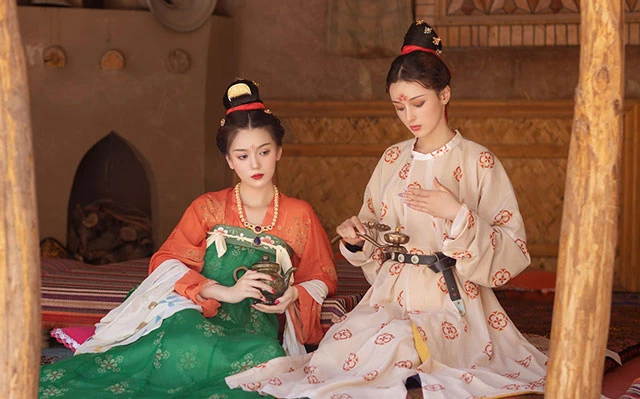
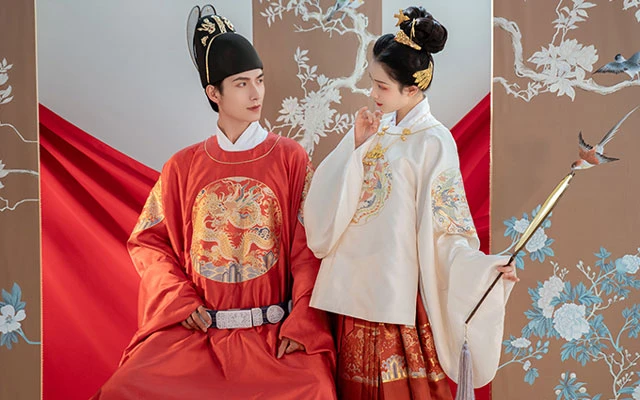
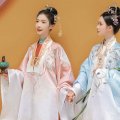

Woah! I had no idea that you could make clothes out of fish's skin. The ingenuity in such a feat is truly remarkable!!
nice article!
Interesting ><
waw! thanks for the article👍
Please note that the images in the Ethnic Minorities section are like... "cosplay". Simplified, sexified, and beautified (although the real ones are no less beautiful!). Also, what the heck is going on with the Mongolian image's foot 😂
Wow, this broaden my knowledge in hanfu and it even talks about minorities which is rarely mentioned in articles. Thank you!!!
Hanfu looks very beautiful
Hanfu tradisional bagus, Entik minoritas juga bagus gaya pakaiannya
I find it interesting that there are many different type of style of Hanfu
This is my best favorite article so far. I still come back to read it again and again.
Traditional Chinese dress is a great art
Traditional costumes such as a roll of a long book, records the different geographical culture of ideological and cultural psychology circles.
I like how that is. Very meaningful.